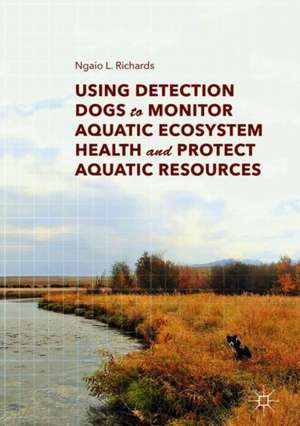Using Detection Dogs to Monitor Aquatic Ecosystem Health and Protect Aquatic Resources
Editat de Ngaio L. Richardsen Limba Engleză Hardback – 29 aug 2018
| Toate formatele și edițiile | Preț | Express |
|---|---|---|
| Paperback (1) | 1109.92 lei 43-57 zile | |
| Springer International Publishing – 15 ian 2019 | 1109.92 lei 43-57 zile | |
| Hardback (1) | 1120.99 lei 43-57 zile | |
| Springer International Publishing – 29 aug 2018 | 1120.99 lei 43-57 zile |
Preț: 1120.99 lei
Preț vechi: 1367.06 lei
-18% Nou
Puncte Express: 1681
Preț estimativ în valută:
214.50€ • 224.56$ • 177.49£
214.50€ • 224.56$ • 177.49£
Carte tipărită la comandă
Livrare economică 07-21 aprilie
Preluare comenzi: 021 569.72.76
Specificații
ISBN-13: 9783319773551
ISBN-10: 3319773550
Pagini: 353
Ilustrații: LIX, 337 p. 71 illus., 68 illus. in color.
Dimensiuni: 148 x 210 x 36 mm
Greutate: 0.79 kg
Ediția:1st ed. 2018
Editura: Springer International Publishing
Colecția Palgrave Macmillan
Locul publicării:Cham, Switzerland
ISBN-10: 3319773550
Pagini: 353
Ilustrații: LIX, 337 p. 71 illus., 68 illus. in color.
Dimensiuni: 148 x 210 x 36 mm
Greutate: 0.79 kg
Ediția:1st ed. 2018
Editura: Springer International Publishing
Colecția Palgrave Macmillan
Locul publicării:Cham, Switzerland
Cuprins
Introduction; Heath Smith.- Chapter 1: Water Search Overview: Searching with Dogs in an Aquatic Environment; Debra Tirmenstein and Robert Freedline.- Chapter 2: Detection Dogs as Ambassadors and Field Assistants to Protect Imperiled Reptiles and Amphibians; Robyn Powers.- Chapter 3: Monitoring Invasive and Threatened Aquatic Amphibians, Mammals and Birds; Jim Shields and Lana Austin (with a contribution from Megan Vick and Todd Engelmeyer).- Chapter 4: Intercepting Invasive Invertebrate Species Before They Infest Water Bodies: The Inception and Implementation of Alberta’s Dedicated Canine Mussel Inspection Program;Cindy Sawchuk (with a contribution from Aimee Hurt).- Chapter 5: In situ Detection of Sewage Pollution and its Sources in Aquatic Ecosystems; Karen Reynolds and Scott Reynolds.- Chapter 6: Using Scat Detection Dogs to Monitor Environmental Contaminants in Sentinel Species and Freshwater Ecosystems; Ngaio Richards, Gregg Tomy, Chad Kinney, Frankline Nwanguma, Braden Godwin and Deborah (Smith) Woollett.- Chapter 7: A Glimpse into the Use of Dogs to Address Global Poaching, Overharvesting and Trafficking of Aquatic Species; Birgit Braun and John Stuart (with contributions from Detective Lauren Wendt and the TRAFFIC India/WWF India Super Sniffer Team).- Chapter 8: Striving for Best Standards and Practices: Recommendations for Optimizing Assessment and Performance of Ecological Scent Detection Dogs; Brian Boroski and Lauralea Oliver.- Chapter 9: Looking Ahead: Future Directions and Considerations for Using Detection Dogs in Aquatic Environments and Ecosystems; Ngaio Richards.
Notă biografică
Ngaio L Richards, PhD, is the Forensics & Field Specialist and a canine handler with Working Dogs for Conservation (WD4C). She has contributed extensively to the applied conservation and wildlife forensics literature and edited the seminal textbook Carbofuran and Wildlife Poisoning: Global Perspectives and Forensic Approaches. Ngaio is happiest in secluded wilderness, accompanied by a dog.
Textul de pe ultima copertă
This book is about the varied range of emerging applications using specially trained detection dogs to monitor and protect aquatic ecosystems, animals, plants and related resources. Featuring contributions from those at the forefront of converging disciplines ranging from canine training, ecological and biological monitoring, water resource management, law enforcement, and eco-toxicology, it addresses everyone already immersed in these or related fields, and anyone seeking to gain a broader understanding of them. Chapters cover several common themes including monitoring presence/absence through biological and ecological surveys; maintaining and evaluating water quality; law enforcement and anti-poaching initiatives; public education, awareness and compliance; standards and best practices; optimal uses of dogs in relation to and in conjunction with other available tools and pragmatic considerations for selecting and working with dogs and handlers. The aim of the book is to stimulate new ideas, promote the sharing and dissemination of information and findings - and, ideally, to catalyze new and innovative partnerships, to strengthen the preservation and conservation of our aquatic heritage.
Caracteristici
Brings together currently disparate aspects of aquatic applications of conservation detection dogs Explores the role of detection dogs and their viability in gathering crucial data from often cryptic or elusive sources as part of terrestrial conservation Promotes sharing and dissemination of information within the field
